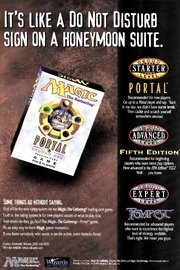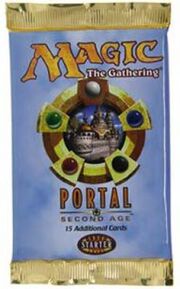Template:Infobox expansion Portal Second Age is a starter-level set released in june 1998 as a follow-up to Portal.[1] As with its predecessor, Portal Second Age was not legal in any officially sanctioned format at the time of its release, but was made legal for Vintage and Legacy tournaments on 20th October 2005.[2]
Set details
Portal Second Age was an additional attempt after Portal to release a simplified version of Magic: the Gathering. The set contains 165 black-bordered cards (55 rare, 55 uncommon, and 55 commons).
Marketing

Portal Second Age and the new rating system

Portal Second Age booster
Portal Second Age was the first set that was advertized as a starter-level set in the new rating system for the game sets. Released in June 1998, the set was sold in 15-card booster packs, five different theme decks and a 2-Player Starter Set. The boosters feature art from Relentless Assault. Demogame boosters were given away as a free product to advertise the game. They contained 24 standard Portal Second Age cards and a tip card. The Official Guide to Portal Second Age is a complete companion to the set and provides useful tips and details to enhance gaming experience.
Like Portal, Portal Second Age was specifically designed for easing new players into the game. It featured the same simplified rules set that Portal used, having no artifacts or enchantments in it, adding sword and shield symbols to the creature cards' power and toughness to denote which number was which, and writing rules text in bold type and separating it from the flavor text with a thick line to show that they were separate. The set also did not have any instants or interrupts, instead having a few sorceries that could be played at times that sorceries normally could not, such as Mystic Denial, which could only be played in response to a creature or sorcery spell, and Just Fate, which could only be played during an opponent's declare attackers step. All such cards have since received errata to make them actual instants.[3]
However, there were two significant differences between Portal Second Age and the original Portal set. Firstly, Portal Second Age used the proper Magic terminology of Library, Graveyard and Blocking, rather than using the Portal terms Deck, Discard Pile and Intercepting. This was done to make the transition from Portal Second Age up to an advanced or expert-level expansion as easy as possible, as it had been found that players going from Portal upwards were often confused by the use of different terms. Secondly, the creature cards in Portal Second Age all had creature types, whereas in Portal all creature cards just had a type line saying "Summon Creature." Portal Second Age is particularly notable for being the first set to say "Creature -" on the type line instead of Summon, a practice that would later be adopted as standard.
Storyline
Unlike Portal, Portal Second Age had its own storyline. It was set on the Dominarian island of Caliman and focused on the conflicts between the five different peoples (one for each color) that lived on it: the White-aligned kingdom of Alaborn, the Talas merchant/pirates, the Goblins and other mountain-dwellers, the Elves of Norwood forest and the Dakmor Nightstalkers, with the main focus being on the increasing nightstalker attacks on the Alaborn due to the influence of the sorceress Tojira. The story was told exclusively through the cards and was deliberately open-ended, with the idea being that players could construct decks around the different tribes and play out the story in-game.
The flavor of the set is probably its most controversial aspect. The main point of contention is the Alaborn use of firearms, as seen on cards such as Alaborn Musketeer and Alaborn Zealot.[4][5] This was badly received by players as it was seen as too real-world and grated with the traditional swords-and-sorcery fantasy setting, particularly as the story took place on Dominaria, where guns had never been depicted before. Since the set was released, other cards have shown advanced technology, such as Urza's Titan engines, but it is generally made clear that such devices are magical in nature.
Themes and mechanics
Like its predecessor, Portal Second Age introduces no new themes or mechanics to Magic, and was essentially a basic set without instants, enchantments, or artifacts.
Creature types
The following creature types are introduced in this set: Merchant (later changed to Pirate), Monkey (later change to Ape), Ox.
The following creature types are used in this expansion but also appear in previous sets: Angel, Basilisk, Bat, Bear, Cat, Dragon, Drake, Elemental, Elf,Giant, Goblin, Griffin, Horror, Knight, Nightstalker, Ogre, Rat, Scorpion, Ship (later changed to Pirate), Serpent, Soldier, Spirit, Wall, Wizard, Wolf, Wurm, Yeti.
Notable cards
Although Portal Second Age was designed to be simple and included lots of reprints of cards from the previous Portal set, it also produced several noteworthy cards:
- Angel of Mercy was first printed in the set. It has since been reprinted in Invasion and in two core sets.
- Bee Sting is one of very few Green direct-damage spells. It is also a functional reprint of Unyaro Bee Sting. Its high cost reflects how bad Green is at dealing direct-damage.
- Brimstone Dragon is one of the most valuable cards in the set as it has only ever been printed in Portal Second Age. It was in contention for reprint in Tenth Edition, but lost out to Shivan Hellkite in a public vote, placing only tenth out of eleven cards.
- Dakmor Sorceress is another very popular card in the set. As there were no legendary cards in the set, the sorceress probably represents Tojira, the Swamp Queen.
- Portal Second Age had a theme of Goblin tribal cards, as is seen on Goblin Matron, Goblin General and Goblin War Strike. This was probably included to teach new players about the significance of the creature types on cards.
- Goblin Raider, a core set staple, was first printed in the set.
- Lone Wolf was first printed in the set, but has gone on to be reprinted multiple times. Its ability is known as super trample and was designed as a way of bringing a trample-like effect into the set without actually using the keyword. The other card in the set with this ability was Deathcoil Wurm.
- Ogre Taskmaster was first printed in the set and has since been reprinted four times.
- Prowling Nightstalker is unusual as its ability mimics fear, but it has not received errata to give it the keyword ability. The reason it can only be blocked by black creatures rather than by black and/or artifact creatures is that there were no artifacts in the set, so the proper text for fear would not have made sense to a new player.
- Ravenous Rats, a classic black card, was first printed in the set.
- Wildfire was first printed in Portal Second Age and was quickly reprinted in Urza's Saga. It has since seen play in 'vore decks after being reprinted in Ninth Edition.
Reprints
Reprinted cards
The following cards have been reprinted from previous sets and included in Portal Second Age:
|
|
Functional reprints
Portal Second Age has 22 functional reprints:
- Alaborn Cavalier is a functional reprint of Seasoned Marshal from Portal, save for creature type.
- Alaborn Veteran is a functional reprint of Stern Marshal from Portal, save for creature type.
- Alaborn Trooper is a functional reprint of Regal Unicorn from Portal, save for creature type.
- Apprentice Sorcerer is a functional reprint of Capricious Sorcerer from Portal.
- Bear Cub is a functional reprint of Grizzly Bears from Portal, Balduvian Bears from Ice Age and Barbary Apes from Legends, save for creature type.
- Dakmor Bat is a functional reprint of Bog Imp from Portal, save for creature type.
- Dakmor Scorpion is a functional reprint of Skeletal Snake from Portal, save for creature type.
- False Summoning is a functional reprint of Remove Soul from Fifth Edition.
- Goblin Mountaineer is a functional reprint of Mountain Goat from Portal, save for creature type.
- Goblin Piker is a functional reprint of Goblin Bully from Portal, save for creature type.
- Goblin Raider is a functional reprint of Hulking Goblin from Portal, save for creature type.
- Ironhoof Ox is a functional reprint of Charging Rhino from Portal, save for creature type.
- Moaning Spirit is a functional reprint of Feral Shadow from Portal, save for creature type.
- Norwood Riders is a functional reprint of Stalking Tiger from Portal, save for creature type.
- Ogre Warrior is a functional reprint of Hill Giant from Portal and Tor Giant from Ice Age, save for creature type.
- Raiding Nightstalker is a functional reprint of Bog Raiders from Portal, save for creature type.
- River Bear is a functional reprint of Bull Hippo from Portal, save for creature type.
- Talas Air Ship is a functional reprint of Snapping Drake from Portal, save for creature type.
- Talas Scout is a functional reprint of Storm Crow from Portal, save for creature type.
- Talas Warrior is a functional reprint of Phantom Warrior from Weatherlight, save for creature type.
- Volunteer Militia is a functional reprint of Devoted Hero from Portal, save for creature type.
- Wild Ox is a functional reprint of Anaconda from Portal, save for creature type.
Since there are no instants in Portal Second Age some cards were reprinted as sorceries:
- Bloodcurdling Scream is a sorcery version of Howl from Beyond from Fifth Edition.
- Chorus of Woe is a sorcery version of Scare Tactics from Exodus (which was released at the same time).
- Salvage is a sorcery version of Reclaim from Exodus (which was released at the same time).
Theme decks
- For the content of the decks in the 2 Player Starter Set, see Portal Second Age 2 Player Starter Set.
Each of the five theme decks contain 3 rares. The preconstructed theme decks are:
| Theme deck name |
Colors Included | ||||
|---|---|---|---|---|---|
| Goblin Fire | R | ||||
| Martial Law | W | ||||
| Nature's Assault | G | ||||
| Nightstalkers | B | ||||
| Spellweaver | U | ||||
References
- ↑ Mark Rosewater (August 30, 2010). "Thank You Sir, May I Have Another". magicthegathering.com. Wizards of the Coast.
- ↑ Aaron Forsythe (Friday, March 11, 2005). "More About March 1st". magicthegathering.com. Wizards of the Coast.
- ↑ Magic Arcana (April 15, 2004). "Portal instants". magicthegathering.com. Wizards of the Coast.
- ↑ Magic Arcana (November 14, 2002). "Gun control". magicthegathering.com. Wizards of the Coast.
- ↑ Doug Beyer (December 12, 2007). "Goodies from the Mailbag". magicthegathering.com. Wizards of the Coast.
